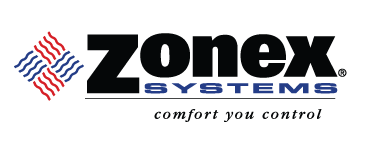VVT is an HVAC control system that stands for Variable Volume & Variable Temperature control. VVT is a cost effective way for building occupants to maintain & control temperature by creating individual zones within the conditioned space. VVT systems were developed to convert a constant volume unit to a VVT type system called change over bypass VAV. Each zone contains a thermostat that controls temperature for the area it is installed in by controlling a modulating supply air damper (see picture at the bottom of this page). VVT systems can be found in commercial buildings with HVAC units (both roof top and split systems) up to 25 tons equipped with a constant volume, multispeed or variable speed fan. The main components of a VVT system are the Control Board (or brain), Zone Dampers, Thermostats, and Bypass Damper (see system image below).
RTU with VVT Zone System

Zone Dampers
Zone dampers are designed to control the amount of conditioned air that is delivered to each zone modulating a “damper blade” open or closed. Inside the damper is a blade that can limit amount of air that flows through the damper and into the zone. Air through the damper can be regulated from 0 – 100% flow. Dampers come in round or rectangular configurations and are installed inline with the duct work.

Thermostats
The primary functions of the thermostats are to indicate the current zone temperature & set point, communicate to the control board the need for either cooling or heating within the zones they reside, to control base board heaters or reheat coils, and to modulate the zone damper either open or close. As temperature in the zone approaches the set point the thermostat will modulate the damper closed. Conversely, the further the zone’s temperature is from the set point the more the thermostat will modulate the damper open to allow for more air to flow to the zone.

Control Board
The primary functions of the control board (or brain) are to gather information from the thermostats and to determine what mode the HVAC unit is to operate in (either heating or cooling). The control board is connected to the thermostats via a serial communication bus over twisted pair wiring and collects information from the thermostats about the need for either heating or cooling in their respective zones. The control board polls the thermostats every 60 seconds. Each thermostat casts a “vote” for either heating or cooling based on the need in their respective zone. Based on the majority number of “votes” the control board will operate the HVAC unit in either the heating mode or cooling mode.

Bypass Dampers
The final component of the system is the bypass damper, which diverts air back to the return air plenum of the HVAC unit based on the amount of static pressure in the supply air plenum ensuring a constant volume of air flows over the coil. When zone dampers modulate to the closed position excess static pressure can build up in the supply air plenum due to the constant volume supply air fan. Excess static pressure in the supply air ducts can cause undesirable noise at the supply air registers and diminish control and comfort. When static pressure in the supply air plenum RISES ABOVE the design rating the bypass damper will modulate OPEN. When static pressure in the supply air plenum DROPS BELOW the design rating the bypass damper will modulate to the CLOSED position. The bypass damper is sized for 100% of the HVAC unit’s CFM rating.






